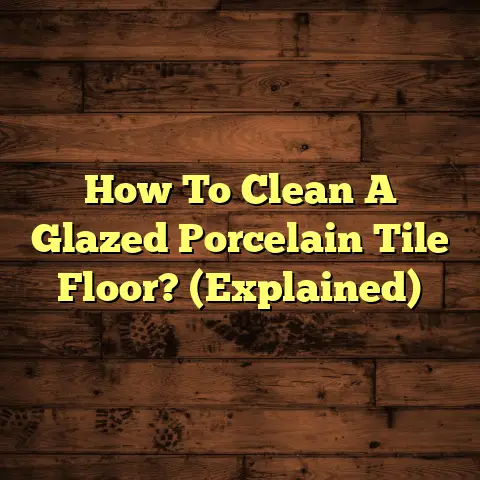Remove Polish From Wood Floors Safely? (4 Steps!)
I’ve seen a huge shift lately in how people are taking care of their homes, especially when it comes to those gorgeous wood floors.
More and more, I’m talking to folks who want to ditch the harsh chemicals and embrace a more sustainable, eco-friendly approach.
And honestly, I couldn’t be happier!
There’s something about the natural beauty of real wood that just adds warmth and elegance to a space.
But let’s be real, those floors need some TLC to keep them looking their best.
Now, I know many of you have reached for that bottle of floor polish, hoping to bring back that showroom shine.
And that’s totally understandable!
However, what I’ve noticed over the years is that those polishes can actually cause more problems than they solve.
I’m talking about buildup that dulls the finish, sticky residues, and a whole lot of frustration.
That’s why I’m so passionate about finding safer, more effective ways to remove that polish without damaging your precious wood floors.
In this article, I’m going to walk you through a simple, four-step process that I’ve perfected over years in the flooring business.
Trust me, it’s easier than you think, and the results are totally worth it.
We’re going to get those floors looking beautiful again, naturally!
Section 1: Understanding the Problem of Polish Buildup
Definition of Polish and Its Uses
Okay, so what exactly is this “floor polish” we’re talking about?
Well, it’s usually a liquid or paste product that’s designed to add a protective layer and a glossy shine to your wood floors.
Think of it as a temporary topcoat.
Most polishes contain waxes, polymers, and solvents.
These ingredients work together to create a film on the surface of the wood.
The goal is to protect against scratches, scuffs, and everyday wear and tear.
Plus, let’s be honest, that shiny finish can really make a room pop.
I get why people use it!
Signs of Polish Buildup
But here’s the thing: over time, that polish can start to build up.
I’ve seen it happen so many times.
Instead of a beautiful shine, you end up with a cloudy or dull finish.
It’s like a film is sitting on top of the wood, masking its natural beauty.
Another telltale sign is a sticky residue.
If your floors feel tacky or attract dirt like crazy, that’s a good indication of polish buildup.
You might also notice an uneven sheen across the floor.
Some areas might look shiny, while others appear dull and lifeless.
It’s not a good look, trust me!
Dangers of Improper Removal
Now, I know what you’re thinking: “Okay, I’ll just grab some heavy-duty cleaner and scrub it off!”
Whoa there!
That’s where you can really get into trouble.
Using harsh chemicals or abrasive methods to remove polish can seriously damage your wood floors.
I’m talking about scratching the finish, stripping the wood, or even causing discoloration.
I’ve seen floors ruined by well-intentioned homeowners who just didn’t know the right way to do things.
That’s why it’s so important to take a gentle, methodical approach.
We want to remove the polish without harming the wood underneath.
Section 2: Preparing for the Removal Process
Gather Necessary Supplies
Alright, let’s get down to business.
Before we start removing that polish, we need to gather our supplies.
Here’s what I recommend:
Soft Cloths: Microfiber cloths are my go-to.
They’re gentle on the wood and super absorbent.Mop: A good quality mop will make the job much easier.
I prefer a microfiber mop head.-
Bucket: You’ll need a bucket to hold your cleaning solution.
Distilled White Vinegar: This is our secret weapon!
Vinegar is a natural cleaner and degreaser that’s safe for wood floors when diluted properly.pH-Neutral Wood Floor Cleaner: We’ll use this for the initial cleaning.
Make sure it’s specifically designed for wood floors.-
Warm Water: For rinsing.
Safety Precautions
Okay, safety first!
Before you start, make sure you take a few simple precautions.
-
Wear Gloves: This will protect your hands from the cleaning solution.
-
Ventilation: Open windows or turn on a fan to ensure proper ventilation in the area.
Test Area: Always test your cleaning solution on a small, inconspicuous area of the floor first to make sure it doesn’t cause any damage.
I usually test in a closet or under a rug.
Initial Cleaning
Before we even think about removing the polish, we need to clean the floor.
This will remove any dirt, dust, or debris that could interfere with the removal process.
Here’s how I do it:
-
Sweep or Vacuum: Start by sweeping or vacuuming the floor to remove loose dirt and debris.
-
Prepare Cleaning Solution: Mix your pH-neutral wood floor cleaner with warm water according to the manufacturer’s instructions.
-
Mop the Floor: Dip your mop into the cleaning solution, wring it out thoroughly, and mop the floor in sections.
-
Rinse the Mop: Rinse your mop frequently to avoid spreading dirt around.
-
Dry the Floor: Use a clean, dry cloth to dry the floor thoroughly.
Let the floor dry completely before moving on to the next step.
Section 3: The Four Steps to Safely Remove Polish from Wood Floors
Alright, here’s the moment you’ve been waiting for!
Let’s get that polish off your floors.
Step 1: Test a Small Area
I know I already mentioned this, but it’s so important that I’m going to say it again: test your cleaning solution on a small, inconspicuous area of the floor first!
I can’t stress this enough.
You want to make sure that the vinegar solution doesn’t damage or discolor your wood.
Apply a small amount of the solution to the test area, let it sit for a few minutes, and then wipe it away with a clean cloth.
Check for any adverse reactions, like discoloration or finish damage.
If everything looks good, you can move on to the next step.
Step 2: Prepare the Cleaning Solution
Okay, now it’s time to mix up our magic potion!
For this, we’re going to use a simple solution of distilled white vinegar and water.
Here’s the recipe I recommend:
- 1/2 cup distilled white vinegar
- 1 gallon of warm water
Mix the vinegar and water together in your bucket.
Why vinegar?
Well, vinegar is a natural acid that helps to break down the wax and polymers in the floor polish.
It’s also a great degreaser, which means it will help to remove any sticky residue.
Plus, it’s safe for wood floors when diluted properly.
Step 3: Application of the Solution
Alright, grab your mop or a soft cloth.
We’re going to start applying the vinegar solution to the floor.
Here’s how I do it:
Dip and Wring: Dip your mop or cloth into the vinegar solution and wring it out thoroughly.
You want it to be damp, not soaking wet.-
Work in Sections: Work in small sections, about 4×4 feet at a time.
-
Apply Solution: Apply the solution to the floor, using a gentle scrubbing motion.
Let it Sit: Let the solution sit on the floor for a few minutes to allow it to break down the polish.
Don’t let it sit for too long, or it could damage the wood.
I usually wait about 3-5 minutes.-
Wipe Away: Use a clean, damp cloth to wipe away the solution and the loosened polish.
Important Tip: Avoid oversaturating the floor with the solution.
Too much water can seep into the wood and cause damage.
Step 4: Rinse and Dry
Okay, we’re almost there!
The final step is to rinse the floor with clean water and dry it thoroughly.
Here’s how I do it:
Rinse the Floor: Use a clean mop or cloth to rinse the floor with clean, warm water.
Make sure to remove all traces of the vinegar solution.Dry the Floor: Use a clean, dry cloth to dry the floor thoroughly.
This is super important!
Any remaining moisture can lead to water damage or future buildup.-
Air Dry: Let the floor air dry completely before walking on it or replacing furniture.
And that’s it! You’ve successfully removed the polish from your wood floors.
Give yourself a pat on the back!
Section 4: Aftercare and Maintenance of Wood Floors
Okay, so you’ve got your floors looking beautiful again.
Now, let’s talk about how to keep them that way!
Preventing Future Buildup
The best way to avoid polish buildup is to prevent it in the first place.
Here are a few tips:
-
Clean Regularly: Sweep or vacuum your floors regularly to remove dirt and debris.
-
Use the Right Products: Only use wood floor cleaners that are specifically designed for your type of finish.
Avoid Over-Polishing: Don’t apply floor polish too often.
Once or twice a year is usually plenty.-
Consider Alternatives: Explore alternatives to traditional floor polish, like wood floor restorers or rejuvenators.
Choosing the Right Products
When it comes to wood floor cleaners and polishes, it’s important to choose the right products.
Here’s what to look for:
-
pH-Neutral: Choose cleaners that are pH-neutral to avoid damaging the finish.
-
Water-Based: Water-based products are generally safer for wood floors than solvent-based products.
-
Non-Toxic: Look for products that are non-toxic and environmentally friendly.
-
Avoid Wax-Based Polishes: Wax-based polishes can create a buildup over time.
Regular Maintenance Schedule
To keep your wood floors looking their best, I recommend following a regular maintenance schedule:
-
Daily: Sweep or vacuum to remove dirt and debris.
-
Weekly: Mop with a pH-neutral wood floor cleaner.
-
Monthly: Inspect the floor for any signs of damage or wear.
-
Annually: Consider applying a wood floor restorer or rejuvenator to protect the finish.
Conclusion: Embracing a Healthier Home Environment
So, there you have it!
A simple, effective, and safe way to remove polish from your wood floors.
I hope this article has been helpful.
Remember, caring for your wood floors doesn’t have to be a chore.
By following these tips, you can keep your floors looking beautiful for years to come.
And more importantly, you can create a healthier, more sustainable home environment for yourself and your family.
I truly believe that taking care of our homes naturally is not only good for the environment, but it’s also good for our well-being.
There’s something incredibly satisfying about knowing that you’re using safe, non-toxic methods to keep your home clean and beautiful.
So, go ahead, embrace the natural beauty of your wood floors.
You’ll be amazed at the results!





